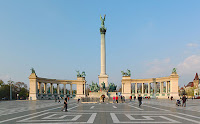Since I have quite a lot of family and friends visiting over the next couple of months, I thought that it would be a good opportunity to play "tour guide" and learn about some of the sights of Budapest. And so, in no particular order, I'm going to start with Heroes Square, or Hősök tere as it's known in Hungarian.
Heroes Square is on the Pest side of the river, and at the end of the lovely tree-lined Andrassy Avenue (oh dear, this is already starting to sound like a tourist brochure - I apologise in advance). It's also on the number 1 metro line (the yellow line), and rather unsurprisingly you just have to get off at Hősök tere.
As you can see from the picture, it's a big column along with lots of statues - yeah, okay, that description doesn't really do it justice. It's actually a really nice place, a large square with the Museum of Fine Arts on one side and the Palace of Art on the other - both beautiful buildings in their own right.
The main monument was finished in 1900 and is called the Millenium Monument. It was apparently constructed when Hungary was part of the Austro-Hungarian Empire. The statues at the base of the main column are the 7 tribal leaders who originally formed Hungary, while the statues in the semi-circle part of the monument represents various saints and important figures in Hungarian history. The first one is Szent Istvan (Saint Stephen), the first king of Hungary, the rest ... well, I'll leave that to you to find out :-)
Just one more thing ... around the square there are also some other places worth visiting ... there's Széchenyi Spa Bath, Vajdahunyad Castle, an ice skating rink, all in the city park behind Heroes Square. Here's a link to some more information about them on Wikipedia.
Just one more thing ... around the square there are also some other places worth visiting ... there's Széchenyi Spa Bath, Vajdahunyad Castle, an ice skating rink, all in the city park behind Heroes Square. Here's a link to some more information about them on Wikipedia.
Ok, that's my tourist-brochure bit of the day :-)




